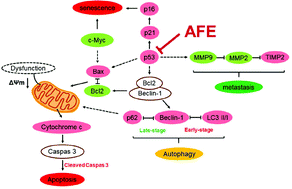Flavonoid-rich extracts from okra flowers exert antitumor activity in colorectal cancer through induction of mitochondrial dysfunction-associated apoptosis, senescence and autophagy†
Abstract
Okra flowers contain a higher content of total flavonoids than most other flowers; however little research has been conducted on their potential benefits, including antitumor activity. In this study, we extracted and purified flavonoids from okra flower (AFE), and aimed to evaluate the effect of AFE and its underlying mechanism on colorectal cancer (CRC) cell growth in vitro and in vivo. Here, we identify that AFE is a safe, natural antioxidant and exerts significant antitumor efficacy on the inhibition of CRC cell proliferation and metastasis as well as tumour growth in vivo. We further reveal that AFE inhibits CRC cell proliferation by inducing mitochondrial dysfunction, which results from the activation of p53 and induction of apoptosis and senescence, and inhibits autophagic degradation. Furthermore, AFE inhibited migration and invasion of CRC cells by regulating the balance of MMP2/TIMP2 and MMP9 expression levels. Of note, administration of AFE as a preventive agent achieves a more effective antitumor effect than the therapeutic agent in a xenograft mouse model. Our results reveal, for the first time, that AFE is a safe, natural antioxidant with significant antitumor efficacy, which has great potential in the application for CRC prevention and treatment.

- This article is part of the themed collection: Food & Function Recent HOT articles


 Please wait while we load your content...
Please wait while we load your content...